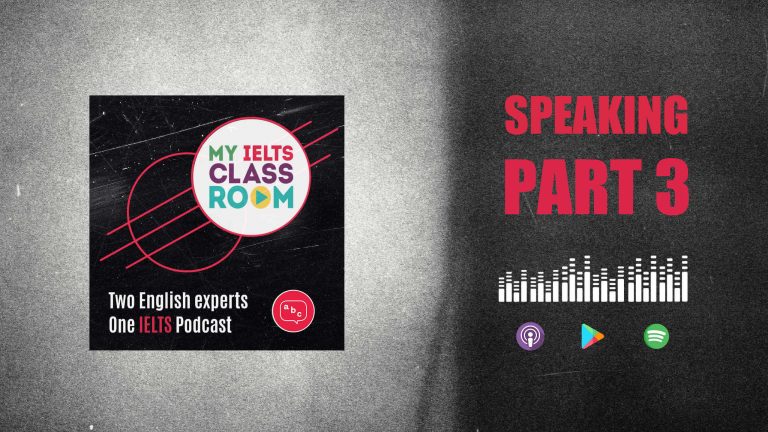
The Best Approach to IELTS Speaking Part 3
IELTS Speaking Part 3
In IELTS Speaking Part 3, the focus moves away from you to the world around you. This means that you will have to be able to speak about abstract topics, which is not easy even for high-level test takers. In the episode above, Nick and I explain how to approach these questions well by looking at the types of question you will be asked, the common topics covered, and the best way to answer the questions in this part of the test.
Plus, if you scroll to the end of this blog post, you can find the second episode where we analyse 5 students attempts at Part 3 to say what they are doing well, and what they need to do to improve their performance.
Below, you can find a summary of the episode, which includes all of the links to useful materials and the times of each part of the discussion (so you can go directly to the part you want to listen to) 🚀
Subscribe to My IELTS Classroom podcast on Apple podcasts here
Subscribe to My IELTS Classroom on Google podcasts here
Podcast Summary: IELTS Speaking Part 3 (PART ONE)
00:00 – 4:39 Introduction (Nick has been on holiday)
04:40 – 15:34 An introduction to IELTS Speaking Part 3
Part 3 has always been my favourite part of the IELTS speaking test as it was the time when the examiner can really “test” a student’s ability to decide if you are a 6.5 or a 7.0, so you really want to to be able to perform well here.
To start today’s lesson, let’s look at some facts about IELTS Speaking Part 3:
- Speaking Part 3 lasts for 4 to 5 minutes and it is the final part of the speaking exam
- In this part, you will have a discussion of a more abstract nature with the examiner. The questions are connected to the topic of your cue card in Part 2. So, if your cue card asked you to “Describe a time when you were angry”, in Part 3, you may be asked questions about “expressing feelings” and “positive and negative emotions”
- The examiner can also ask follow-up questions in part three, so be prepared to justify or explain your responses further.
Let’s talk more about the three sets of questions the examiner has.
These are divided according to difficultly, with sets one and two being designed to test students who are band score 6.5 or less and set three being designed to test students who are band score 7.0 or higher.
Let me be clear, all of the questions in all of the sets still ask you to talk about the world around you, but those in sets one and two are slightly less abstract than those in set three. Let me show you some examples:
- Set One Sample Question: Which apps or computer programs are popular in your country?
- Set Two Sample Question: Do you think parents should limit the time that children spend on apps?
- Set Three Sample Question: Do you think IT gives people more information but not greater wisdom?
Can you see the difference? You can usually answer the questions in sets one and two by describing trends that you can see in the real world around you, whereas to answer those in set three you will need to use high-level logic and reasoning. This is not easy!

Also, you should be prepared to be interrupted in IELTS Speaking Part 3. The examiner only has 4 or 5 minutes to check your exact level so if you start to give an answer that is off-topic, or begin to repeat the same idea again and again in different words, or just give an answer that is not justified, the the examiner will interrupt you. THIS IS TOTALLY FINE and will not affect your score. You can read much more about why an examiner could interrupt you in this blog post.
15:36 – 33:14 What language do you have to produce to score highly in IELTS Speaking Part 3?
While topics you have to discuss and the actual questions are different in every test, the “functions” or the type of language that you are asked to show is always the same. In general, in IELTS Speaking Part 3, you will need language to
- compare
- agree/disagree with a statement
- evaluate, consider or assess something’s importance
- give a reason or explanation for a phenomenon
- identify or describe a trend
- predict or speculate about future habits
- suggest a solution to a problem
Interestingly, the examiner never uses the words in bold as they ask the question, so you will need to be able to figure out what you need to do from the language in the question. You can read more about this here.
33:15 – 47:32 What do good responses to IELTS Speaking Part 3 look like?
What makes a response strong or weak in IELTS Speaking Part 3. Good question! In the podcast Nick and I give clear examples and explain:
- why personal examples are not a good idea
- why you don’t want to rely on the same ideas again and again
- why it is so important that you can really answer the question
- why a summary at the end of your turn is not necessary
47:33 – END What can you do if you have no idea what to say?
If you want the highest scores for Task Response, then you are going to struggle to get more than a 7.0 if you don’t have any ideas for the difficult topics that are discussed in Part 3. Yes, there are some techniques that can help you to keep on talking when you have no ideas (which we teach in our Intensive Speaking Course) but I don’t think any student should rely on these in the test.
The best thing that you can do is become familiar with the topics that repeat again and again. You should be prepared to speak about:
- technology
- modern lifestyles
- social change
- education
- leadership
- city life
- films / the arts
- communication / news
- culture / language / identity
- success / money
- business / advertising
- creativity / invention
- environment
- health
Now listen to Nick and I give feedback to 5 students who attempted the following Part 3 Questions to see if they could put all of the above information into action.
In this second episode we will explain
- why examples are not always the best way to support your answer
- how even one mispronounced word can affect your score
- the problem of rapid speech
- the importance of addressing the question well
If you enjoyed this podcast, then you can find all of our live and video lessons on our main website www.myieltsclassroom.com, which is where you can also sign up for one of our IELTS speaking courses or book a personal speaking lesson with Nick or myself. 🚀
